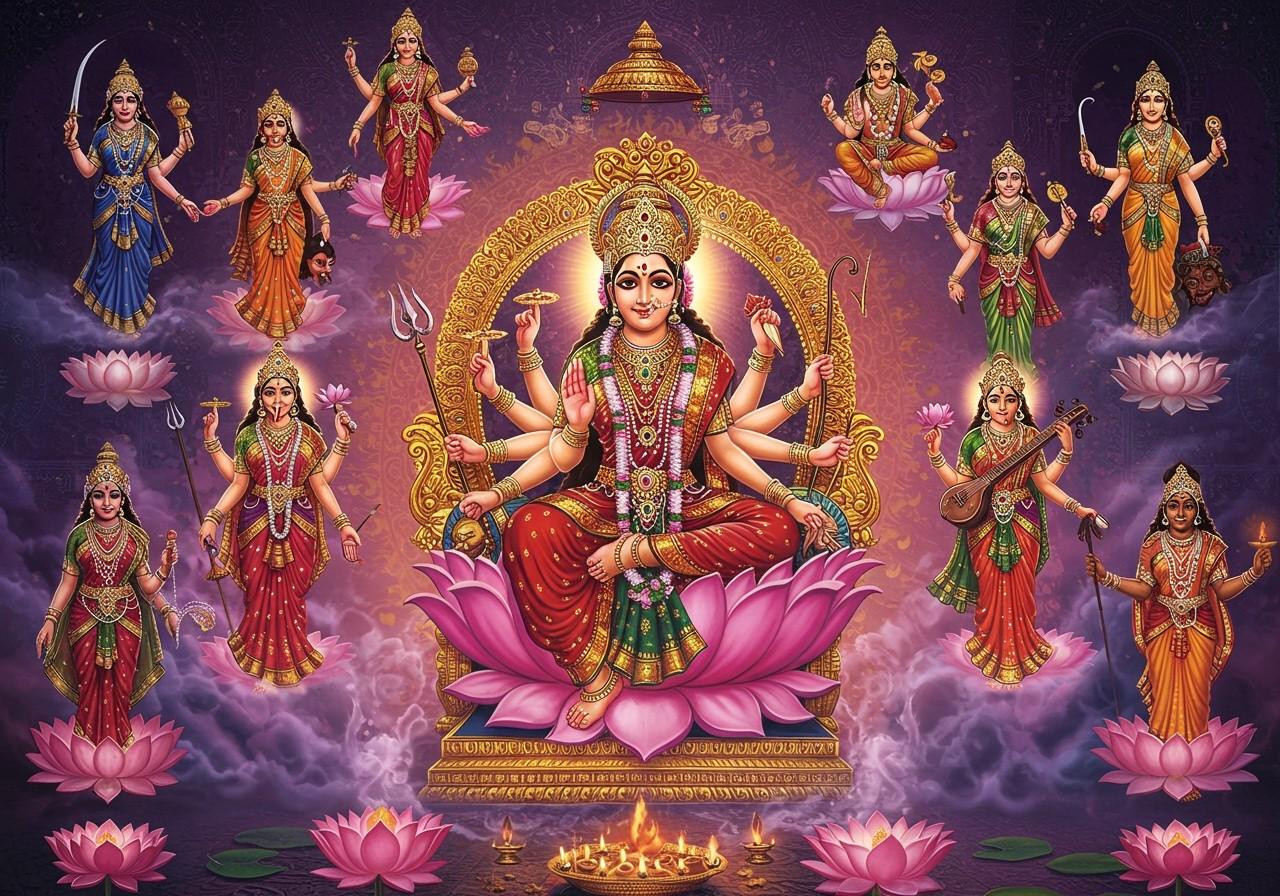
The Mahavidyas, also known as the Dasa Mahavidyas, hold a captivating place in Hindu traditions. These ten Tantric goddesses represent different facets of the Divine Mother, Adi Parashakti. Among them, Tripura Sundari shines brightly, captivating devotees with her divine beauty and profound spiritual significance. These goddesses are deeply ingrained in the cultural and spiritual fabric of India, especially for those who cherish traditional rituals. Understanding their origins and connections can truly enrich one’s spiritual journey.
Understanding the Mahavidyas: Wisdom Goddesses
The Mahavidyas, often referred to as the “Great Wisdom Goddesses,” are central figures in Tantric worship. Each goddess embodies a unique aspect of the divine feminine, their stories woven into sacred texts like the Devi Mahatmya and the Tantrasara. The number ten itself holds symbolic weight in Hinduism, representing wholeness and completion, hence the ten Mahavidyas. They serve as guides, illuminating the path toward enlightenment through their unique teachings and attributes.
Tripura Sundari: The Embodiment of Beauty and Grace
Tripura Sundari, also known as Shodashi or Lalita, radiates a unique allure among the Mahavidyas. Her name, meaning “the beauty of the three worlds,” speaks to her captivating grace, charm, and elegance. Often depicted seated serenely upon a lotus, she symbolizes purity and divine beauty, a visual representation of her elevated status.
However, her association with beauty transcends the physical realm. Tripura Sundari embodies the ultimate reality, Brahman itself. She is deeply revered for her connection to wealth, wisdom, and the pursuit of spiritual truth. As the third Mahavidya, she holds a revered position in the Sri Vidya tradition of Tantra, where she is considered a central figure guiding seekers toward enlightenment.
Tripura Sundari Mahavidya: Significance and Worship
Tripura Sundari’s significance goes far beyond mere aesthetics. She represents the essence of the three worlds and the states of consciousness: waking, dreaming, and deep sleep. Worshipping her is a journey towards understanding these profound concepts, a path of self-discovery guided by her divine presence.
Devotees engage in various rituals, such as reciting the Lalita Sahasranama, a practice of chanting her thousand names, each a reflection of her divine qualities. These rituals are undertaken to invoke her blessings, seeking wisdom, prosperity, and ultimately, spiritual liberation.
Tripura Sundari and Bhuvaneshwari: A Divine Connection
A unique bond connects Tripura Sundari and Bhuvaneshwari, another revered Mahavidya. Both goddesses symbolize aspects of creation and the cosmic order that governs the universe. While Tripura Sundari embodies beauty and wisdom, Bhuvaneshwari represents the boundless expanse of the universe itself.
Their iconography reveals subtle yet significant differences. Tripura Sundari is portrayed as youthful and radiant, while Bhuvaneshwari is depicted as the nurturing world mother. This duality enriches their worship, allowing devotees to explore different facets of the divine feminine, each offering unique insights and blessings.
Cultural and Ritualistic Practices: Connecting with the Divine
The Mahavidyas, including Tripura Sundari, are deeply intertwined with Hindu cultural practices. Festivals like Navaratri and Lalita Jayanti are celebrated with immense devotion and joy, honoring these powerful goddesses. Sacred texts, such as the Lalitopakhyana, serve as guides for worshippers on their spiritual paths.
Yantras and mantras play a significant role in these rituals, aiding in meditation and focus, helping devotees establish a deeper connection with the divine. Through these practices, believers seek to unlock the profound wisdom embodied by the Mahavidyas, enriching their lives with spiritual understanding.
Tripura Sundari and the other Mahavidyas continue to be a source of inspiration and devotion. Their stories and teachings offer invaluable insights into the mysteries of the divine feminine. These goddesses beckon believers to embark on a journey of self-realization and spiritual growth, a path towards deeper understanding and connection.
Poojn Helps You Connect with the Divine Mahavidyas
At poojn.in, we offer authentic puja items and materials specifically curated for worshipping Tripura Sundari and the other Mahavidyas. Our thoughtfully selected collection includes:
- Complete Mahavidya Puja Sets with all the essential items, ensuring you have everything you need for a reverent and fulfilling puja.
- Pure copper yantras for each of the ten Mahavidyas, crafted with precision and imbued with spiritual significance to enhance your connection with the goddesses. Explore our range of yantras and malas here.
- Red silk sarees and offerings for Tripura Sundari, chosen with care to honor her divine beauty and grace. You can find a wide selection of puja sarees and other offerings on our website. Browse our collection of murtis and idols.
- Traditional kumkum and sindoor from trusted sources, ensuring the purity and authenticity of these sacred items.
- Specially crafted diyas and incense for Mahavidya worship, enhancing the ambiance and sanctity of your puja space. Discover our wide variety of diyas and incense.
- Sacred texts and prayer books in multiple languages, allowing you to deepen your understanding of the Mahavidyas and their teachings.
We meticulously ensure that all our items meet traditional requirements and are sourced from reliable, verified suppliers. Our team of experts is available to guide you in selecting the most appropriate items for your specific puja needs, offering personalized assistance and advice.
To place an order or receive detailed guidance about Mahavidya puja items:
- Call: 03369029784
- WhatsApp: 9476142738
- Visit: www.poojn.in
All items are carefully packaged and delivered across India. Our dedicated customer service team provides support in multiple languages, ensuring a seamless and convenient experience as you choose the most suitable items for your spiritual practice.
Embracing the Wisdom of Tripura Sundari and the Mahavidyas
Tripura Sundari and the Mahavidyas offer a wellspring of timeless wisdom and guidance. They represent the divine feminine in all her glory – her beauty, power, and grace. As we delve into their stories and teachings, we find inspiration for our own spiritual journeys.
The rituals and practices dedicated to these goddesses provide a pathway to connect with their potent energies, bringing us closer to understanding ourselves and the intricate workings of the universe. By embracing the Mahavidyas, we honor a rich tradition that values wisdom, beauty, and the pursuit of spiritual growth.
Whether through chanting, meditation, or participating in festivals, each step we take brings us closer to the divine. May the blessings of Tripura Sundari and the Mahavidyas illuminate your life with knowledge, peace, and profound enlightenment as you continue your spiritual journey.
FAQs on Tripura Sundari and the Mahavidyas
What is Tripura Sundari? Tripura Sundari, revered as one of the ten Mahavidyas, the Wisdom Goddesses, embodies beauty, abundance, and the transformative power of love. Often depicted as a youthful goddess, she is considered the epitome of beauty, worshipped for her grace, wisdom, and the blessings she bestows upon her devotees. Learn more about Goddess Lakshmi, the devi of wealth and prosperity, and Devi Saraswati, the goddess of knowledge and wisdom, on our blog. Read about Goddess Lakshmi here. and Discover Devi Saraswati here.
How is Tripura Sundari related to the Mahavidyas? Tripura Sundari is an integral part of the ten Wisdom Goddesses known as the Mahavidyas. Each Mahavidya represents a distinct aspect of the Divine Feminine’s power, and Tripura Sundari embodies beauty and the path to spiritual enlightenment. Deepen your understanding of Mantras and Hindu Gods and Goddesses through our comprehensive guides. Explore the power of Mantras here and discover the world of Hindu deities here.
What is the significance of the Mahavidyas? The Mahavidyas represent ten distinct aspects of the Divine Mother, the Goddess. Each embodies unique qualities such as wisdom, strength, and protection. Together, they guide devotees on their spiritual journeys, offering blessings and support to navigate life’s challenges. Their combined energies create a powerful force for spiritual growth and transformation.
How does Tripura Sundari differ from Bhuvaneshwari? Both Tripura Sundari and Bhuvaneshwari are revered Mahavidyas, yet they represent different aspects of the divine. Tripura Sundari is associated with beauty and the bliss of creation, while Bhuvaneshwari embodies the vastness of space and the world, upholding the universal order. Their distinct energies offer unique perspectives on the divine feminine.
Why is Tripura Sundari important in Hinduism? Tripura Sundari holds a significant place in Hinduism as a symbol of ultimate beauty and wisdom. She guides devotees towards spiritual enlightenment, helping them overcome obstacles and attain prosperity and happiness. Her worship offers a path to self-realization and a deeper connection with the divine.
What are the key symbols of Tripura Sundari? Tripura Sundari is often depicted with symbolic objects such as a noose, goad, sugarcane bow, and flower arrows. These represent her power over the material world and her ability to guide devotees towards spiritual realization. Each symbol holds a deeper meaning, revealing layers of her divine attributes.
How is Tripura Sundari worshiped? Devotees worship Tripura Sundari through various rituals, prayers, and offerings. Chanting mantras and performing pujas are common practices to seek her blessings for beauty, happiness, and wisdom in their lives. These practices create a sacred space for connection and devotion.
Can anyone worship Tripura Sundari and the Mahavidyas? Yes, the worship of Tripura Sundari and the Mahavidyas is open to all who seek their wisdom and grace. They are universal deities, offering guidance and blessings to anyone who approaches them with sincerity and devotion. Their teachings transcend boundaries, embracing all who seek spiritual growth.

